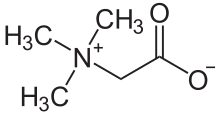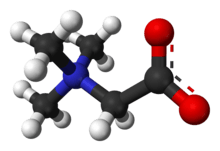Trimethylglycine
Trimethylglycine (TMG) is an amino acid derivative that occurs in plants. Trimethylglycine was the first betaine discovered; originally it was simply called betaine because, in the 19th century, it was discovered in sugar beets.[2] Since then, many other betaines have been discovered, and the more specific name glycine betaine distinguishes this one.
 | |
 | |
| Names | |
|---|---|
| IUPAC name
2-trimethylammonioacetate | |
Other names
| |
| Identifiers | |
3D model (JSmol) |
|
| 3537113 | |
| ChEBI | |
| ChEMBL | |
| ChemSpider | |
| DrugBank | |
| ECHA InfoCard | 100.003.174 |
| EC Number |
|
| 26434 | |
| KEGG | |
| MeSH | Betaine |
PubChem CID |
|
| UNII | |
CompTox Dashboard (EPA) |
|
| |
| |
| Properties | |
| C5H11NO2 | |
| Molar mass | 117.146 |
| Appearance | White solid |
| Melting point | 180 °C (356 °F; 453 K)[1] (decomposes) |
| Soluble | |
| Solubility | Methanol |
| Acidity (pKa) | 1.84 |
| Pharmacology | |
| A16AA06 (WHO) | |
| License data | |
| Hazards | |
| GHS pictograms |  |
| GHS Signal word | Warning |
GHS hazard statements |
H315, H319 |
| P264, P280, P302+352, P305+351+338, P321, P332+313, P337+313, P362 | |
| Related compounds | |
Related amino acids |
Glycine Methylglycine Dimethylglycine |
Except where otherwise noted, data are given for materials in their standard state (at 25 °C [77 °F], 100 kPa). | |
| Infobox references | |
Structure and reactions
Trimethylglycine is an N-methylated amino acid. It is a zwitterion as the molecule contains both a quaternary ammonium group and a carboxyl group. The carboxyl group will be partially protonated in aqueous solution below pH 4, that is, below pH equal to (pKa − 2).
- (CH
3)
3N+
CH
2CO−
2 (aq) + H+
⇌ (CH
3)
3N+
CH
2CO
2H (aq)
Demethylation of TMG gives dimethylglycine.
Production and biochemical processes
Processing sucrose from sugar beets yields glycine betaine as a byproduct. The value of the TMG rivals that of the sugar content in sugar beets.[3]
Biosynthesis
In most organisms, glycine betaine is biosynthesized by oxidation of choline in two steps. The intermediate, betaine aldehyde, is generated by the action of the enzyme mitochondrial choline oxidase (choline dehydrogenase, EC 1.1.99.1). Betaine aldehyde is further oxidised in the mitochondria in mice to betaine by the enzyme betaine aldehyde dehydrogenase (EC 1.2.1.8).[4][5] In humans betaine aldehyde activity is performed by a nonspecific cystosolic aldehyde dehydrogenase enzyme (EC 1.2.1.3) [6]
Biological function
TMG is an organic osmolyte. Sugar beet was cultivated from sea beet, which requires osmolytes in order to survive in the salty soils of coastal areas. TMG also occurs in high concentrations (~10 mM) in many marine invertebrates, such as crustaceans and molluscs. It serves as a potent appetitive attractant to generalist carnivores such as the predatory sea slug Pleurobranchaea californica.[7]
TMG is an important cofactor in methylation, a process that occurs in every mammalian cell donating methyl groups (–CH3) for other processes in the body. These processes include the synthesis of neurotransmitters such as dopamine and serotonin. Methylation is also required for the biosynthesis of melatonin and the electron transport chain constituent coenzyme Q10, as well as the methylation of DNA for epigenetics.
The major step in the methylation cycle is the remethylation of homocysteine, a compound which is naturally generated during demethylation of the essential amino acid methionine. Despite its natural formation, homocysteine has been linked to inflammation, depression, specific forms of dementia, and various types of vascular disease. The remethylation process that detoxifies homocysteine and converts it back to methionine can occur via either of two pathways. The pathway present in virtually all cells involves the enzyme methionine synthase (MS), which requires vitamin B12 as a cofactor, and also depends indirectly on folate and other B vitamins. The second pathway (restricted to liver and kidney in most mammals) involves betaine-homocysteine methyltransferase (BHMT) and requires TMG as a cofactor. During normal physiological conditions, the two pathways contribute equally to removal of homocysteine in the body[8]. Further degradation of betaine, via the enzyme dimethylglycine dehydrogenase produces folate, thus contributing back to methionine synthase. Betaine is thus involved in the synthesis of many biologically important molecules, and may be even more important in situations where the major pathway for the regeneration of methionine from homocysteine has been compromised by genetic polymorphisms such as mutations in the MS gene.
TMG in agriculture and aquaculture
Factory farms supplement fodder with TMG and lysine to increase livestock's muscle mass (and, therefore, "carcass yield", the amount of usable meat).
Salmon farms apply TMG to relieve the osmotic pressure on the fishes' cells when workers transfer the fish from freshwater to saltwater.[3][9]
TMG supplementation decreases the amount of adipose tissue in pigs; however, research in human subjects has shown no effect on body weight, body composition, or resting energy expenditure.[10]
TMG in the human diet
| Food | TMG (mg/100 g) |
|---|---|
| Quinoa | 630 |
| Spinach | 577 |
| Wheat bran | 360 |
| Lamb's quarters | 332 |
| Beetroot | 256 |
Dietary supplement
Although TMG supplementation decreases the amount of adipose tissue in pigs, research on human subjects has shown no effect on body weight, body composition, or resting energy expenditure when used in conjunction with a low calorie diet.[10] The Food and Drug Administration of the United States approved anhydrous trimethylglycine (also known by the brand name Cystadane) for the treatment of homocystinuria, a disease caused by abnormally high homocysteine levels at birth.[11] TMG is also used as the hydrochloride salt (marketed as betaine hydrochloride or betaine HCl). Betaine hydrochloride was once permitted in over-the-counter (OTC) drugs as a gastric aid in the United States. US Code of Federal Regulations, Title 21, Section 310.540, which became effective on November 10, 1993, banned betaine hydrochloride from being used in OTC products due to insufficient evidence to classify it as "generally recognized as safe and effective".[12]
TMG supplementation may cause diarrhea, stomach upset, or nausea. TMG supplementation lowers homocysteine but also raises LDL-cholesterol.[13]
Other uses: PCR
Trimethylglycine can act as an adjuvant of the polymerase chain reaction (PCR) process, and other DNA polymerase-based assays such as DNA sequencing. By an unknown mechanism, it aids in the prevention of secondary structures in the DNA molecules, and prevents problems associated with the amplification and sequencing of GC-rich regions. Trimethylglycine makes guanosine and cytidine (strong binders) behave with thermodynamics similar to those of thymidine and adenosine (weak binders). It has been determined under experiment that it is best used at a final concentration of 1 M.[14]
Speculative uses
Laboratory studies and two clinical trials have indicated that TMG is a potential treatment of non-alcoholic steatohepatitis.[15][16][17]
TMG has been proposed as a treatment for depression. In theory, it would increase S-adenosylmethionine (SAMe) by remethylating homocysteine. The same homocysteine-to-methionine result could be achieved by supplementing with folic acid and vitamin B12, methionine then serving as a precursor to synthesis of SAMe. SAMe as a dietary supplement has been shown to work as a nonspecific antidepressant.[18]
Research with the goal of developing environmentally safe biomimetic ship coatings is using TMG, among others, as a non-toxic anti-fouling coating.
IEX Ion Exchange Chromatography
In the book from Amersham Biosciences/GE Healthcare, Ion Exchange Chromatography & Chromatofocusing - Principles and Methods, page 48. "Zwitterionic additives such as betaine can prevent precipitation and can be used at high concentrations without interfering with the gradient elution"
References
- Acheson, R. M.; Bond, G. J. F. (1956). "52. Addition reactions of heterocyclic compounds. Part II. Phenanthridine and methyl acetylenedicarboxylate in methanol". J. Chem. Soc. 1956: 246. doi:10.1039/JR9560000246.
- Schiweck, Hubert; Clarke, Margaret; Pollach, Günter. "Sugar". Ullmann's Encyclopedia of Industrial Chemistry. Weinheim: Wiley-VCH. doi:10.1002/14356007.a25_345.pub2.
- Mäkelä, P. (2004). "Agro-industrial uses of glycinebetaine". Sugar Tech. 6 (4): 207–212. doi:10.1007/BF02942500. hdl:10138/312331. S2CID 25219649.
- Kempf, B.; Bremer, E. (1998). "Uptake and synthesis of compatible solutes as microbial stress responses to high-osmolality environments". Arch. Microbiol. 170 (5): 319–330. doi:10.1007/s002030050649. PMID 9818351. S2CID 8045279.
- "BRENDA – Information on EC 1.2.1.8 – betaine-aldehyde dehydrogenase". Brenda-enzymes.org. Retrieved 2016-07-07.
- Chern, M. K.; Pietruszko, R. (1999). "Evidence for mitochondrial localization of betaine aldehyde dehydrogenase in rat liver: purification, characterization, and comparison with human cytoplasmic E3 isoenzyme". Biochemistry and Cell Biology. 77 (3): 179–187. doi:10.1139/o99-030. PMID 10505788.
- Gillette, R.; Huang, R. C.; Hatcher, N.; Moroz, L. L. (March 2000). "Cost-benefit analysis potential in feeding behavior of a predatory snail by integration of hunger, taste, and pain". Proc. Natl. Acad. Sci. USA. 97 (7): 3585–3590. Bibcode:2000PNAS...97.3585G. doi:10.1073/pnas.97.7.3585. PMC 16283. PMID 10737805.
- Finkelstein, J. D. (1998-03-24). "The metabolism of homocysteine: pathways and regulation". European Journal of Pediatrics. 157 (S2): S40–S44. doi:10.1007/pl00014300. ISSN 0340-6199. PMID 9587024.
- Xue, M.; Xie, S.; Cui, Y. (2004). "Effect of a feeding stimulant on feeding adaptation of gibel carp Carassius auratus gibelio (Bloch), fed diets with replacement of fish meal by meat and bone meal". Aquacult. Res. 35 (5): 473–482. doi:10.1111/j.1365-2109.2004.01041.x.
- Schwab, U.; Törrönen, A.; Toppinen, L.; et al. (November 2002). "Betaine supplementation decreases plasma homocysteine concentrations but does not affect body weight, body composition, or resting energy expenditure in human subjects". Am. J. Clin. Nutr. 76 (5): 961–967. doi:10.1093/ajcn/76.5.961. PMID 12399266.
- Holm, P. I.; Ueland, P. M.; Vollset, S. E.; et al. (February 2005). "Betaine and folate status as cooperative determinants of plasma homocysteine in humans". Arterioscler. Thromb. Vasc. Biol. 25 (2): 379–385. doi:10.1161/01.ATV.0000151283.33976.e6. PMID 15550695.
- "CFR - Code of Federal Regulations Title 21". U.S. Food & Drug Administration.
- Olthof MR, van Vliet T, Verhoef P, Zock PL, Katan MB (2005). "Effect of homocysteine-lowering nutrients on blood lipids: results from four randomised, placebo-controlled studies in healthy humans". PLOS Med. 2 (5): e135. doi:10.1371/journal.pmed.0020135. PMC 1140947. PMID 15916468.
- Henke, W.; Herdel, K.; Jung, K.; Schnorr, D.; Loening, S. A. (October 1997). "Betaine improves the PCR amplification of GC-rich DNA sequences". Nucleic Acids Res. 25 (19): 3957–3958. doi:10.1093/nar/25.19.3957. PMC 146979. PMID 9380524.
- Angulo, P.; Lindor, K. D. (2001). "Treatment of nonalcoholic fatty liver: present and emerging therapies". Semin. Liver Dis. 21 (1): 81–88. doi:10.1055/s-2001-12931. PMID 11296699.
- Abdelmalek, M. F.; Sanderson, S. O.; Angulo, P.; et al. (December 2009). "Betaine for nonalcoholic fatty liver disease: results of a randomized placebo-controlled trial". Hepatology. 50 (6): 1818–26. doi:10.1002/hep.23239. PMID 19824078.
- Miglio, F.; Rovati, L. C.; Santoro, A.; Setnikar, I. (August 2000). "Efficacy and safety of oral betaine glucuronate in non-alcoholic steatohepatitis. A double-blind, randomized, parallel-group, placebo-controlled prospective clinical study". Arzneimittelforschung. 50 (8): 722–7. doi:10.1055/s-0031-1300279. PMID 10994156.
- Mischoulon D, Fava M (2002). "Role of S-adenosyl-L-methionine in the treatment of depression: a review of the evidence". Am. J. Clin. Nutr. 76 (5): 1158S–61S. doi:10.1093/ajcn/76.5.1158s. PMID 12420702.
External links
- USDA Database for the Choline Content of Common Foods – including the data on choline metabolites, such as betaine, in 434 food items.